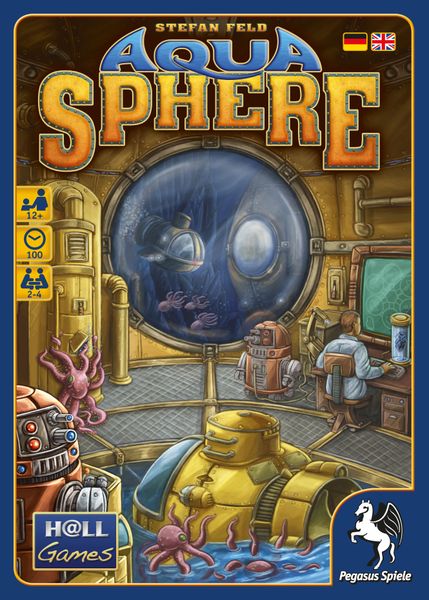AquaSphere (2014) Board Game
Brief History and Background Information for AquaSphere
AquaSphere is a board game designed by Stefan Feld and released in 2014. It is set in a futuristic underwater research facility where players take on the roles of scientists competing to gather resources and research marine life. The game combines elements of nautical and science fiction themes, offering a unique gaming experience for 2 to 4 players.
Game Components of AquaSphere
- Modular game board
- Player boards
- Scientist figures
- Octopods
- Crystals
- Research cards
- Action tiles
- Time markers
How To Setup AquaSphere
- Place the game board in the center of the table.
- Each player chooses a color and takes a player board and scientist figures.
- Shuffle the research cards and place them face down on the board.
- Place the octopods, crystals, and action tiles in their designated spaces.
- Set up the time markers based on the number of players.
Gameplay Mechanics and Game Objective
In AquaSphere, players take turns performing actions to gather resources, upgrade their equipment, and conduct research. The main objective is to earn the most points by the end of the game through efficient use of time and strategic decision-making. Players must manage their actions carefully to outmaneuver their opponents and achieve their goals.
Player Experience: Pros and Cons
Pros:
- Engaging theme that combines nautical and science fiction elements
- Strategic depth with multiple paths to victory
- Varied gameplay mechanics keep the game interesting
- Beautiful artwork and high-quality components
Cons:
- Steep learning curve for new players
- Limited player interaction can make the game feel solitary at times
- Luck of the draw with research cards can heavily influence gameplay
Personal Thoughts on AquaSphere
Overall, AquaSphere is a well-designed and immersive board game that offers a unique gaming experience. The combination of nautical and science fiction themes, along with strategic gameplay mechanics, makes it stand out among other titles in its category. The build quality of the components is excellent, and the artwork by Dennis Lohausen is visually stunning.
In terms of pricing and availability, AquaSphere can be found both new and used at various retailers and online marketplaces. While the game may not be suitable for casual gamers due to its complexity, it is a great choice for players who enjoy deep strategy and thematic immersion. Those who appreciate games with a blend of area majority/influence, area movement, and end game bonuses will find AquaSphere to be worth their time.
For those looking for alternatives or similar games, titles like Terraforming Mars and Underwater Cities may offer a similar experience. Overall, AquaSphere is a solid choice for players who enjoy a challenge and are willing to invest the time to master its mechanics.
Game Components of AquaSphere
How To Setup AquaSphere
Setting up AquaSphere involves several steps:
Gameplay Mechanics and Game Objective
Mechanics
Game Objective
Player Experience
AquaSphere is known for its complexity and strategic depth. Players must navigate a two-step process for taking actions, programming bots before deploying them. The game is divided into four rounds, each followed by intermediate scoring, and culminates in a final scoring round. The scarcity of resources and the need to manage multiple tasks simultaneously make every decision critical. The game challenges players with area control, resource management, and the threat of octopods, all while trying to optimize their lab expansions and submarine placements.
Pros
Cons
Personal Thoughts on AquaSphere
AquaSphere is suited for experienced gamers who enjoy complex, strategic games. It is not for the faint of heart, as it requires careful planning, resource management, and a deep understanding of its mechanics. For those who relish a challenge and are willing to invest time in learning the game, AquaSphere offers a rewarding and engaging experience. However, it may not be the best choice for casual gamers or those new to board games due to its complexity and lengthy setup.
We are supported by our audience. When you purchase through links on our site, we may earn an affiliate commission, at no extra cost for you. Learn more.

